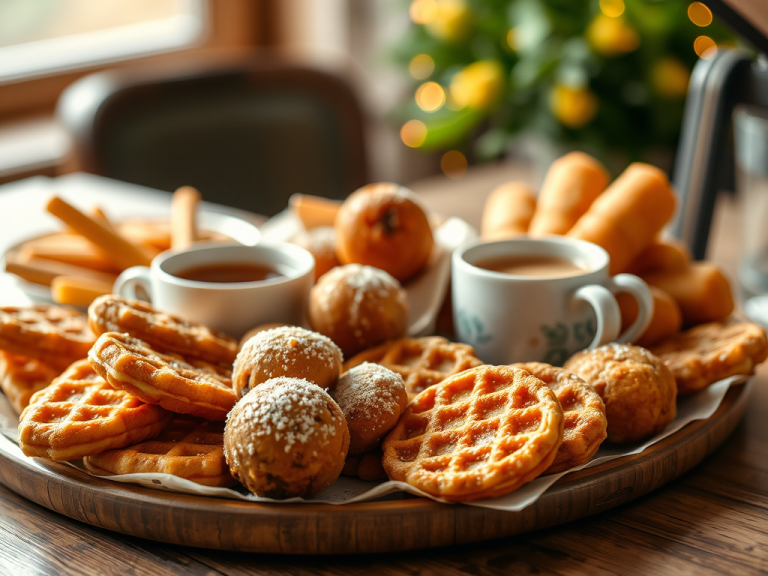Traditional Dutch Desserts to Satisfy Your Sweet Tooth
Traditional Dutch Desserts to Satisfy Your Sweet Tooth
“Did you know that the Netherlands is home to over 200 unique desserts, each with its own story and flavor?” As someone who has spent over two decades writing about culinary delights, I can assure you that Dutch desserts are a treasure trove for anyone with a sweet tooth. These treats are not just about sugar and spice; they are a reflection of rich cultural heritage and historical evolution. So, let’s dive into the world of traditional Dutch desserts and discover what makes them so irresistible.
The Sweet History of Dutch Desserts
When we talk about Dutch desserts, we’re delving into a history that dates back centuries. The Netherlands, with its strategic location and colonial past, has been a melting pot of various cultures and culinary influences. This has significantly shaped its dessert landscape, making it as diverse as it is delicious.
The Influence of Trade and Colonization
The Dutch Golden Age, spanning the 17th century, was a period of great wealth and cultural achievement. During this time, the Dutch East India Company played a pivotal role in the spice trade, bringing exotic ingredients like cinnamon, nutmeg, and cloves to Europe. These spices became integral to Dutch baking, giving rise to many of the flavors we associate with traditional Dutch desserts today.
Evolution of Baking Techniques
As baking techniques evolved, so did the complexity and variety of Dutch desserts. The introduction of sugar refining in the 16th century allowed for the creation of more sophisticated sweets. Over time, Dutch bakers perfected their craft, leading to the development of iconic treats such as stroopwafels and speculaas.
Exploring Iconic Dutch Desserts
Now that we’ve set the stage with a bit of history, let’s explore some of the most beloved Dutch desserts that continue to captivate taste buds around the world.
Stroopwafels: The Sweet Sandwich
Arguably the most famous of all Dutch desserts, the stroopwafel is a delightful combination of two thin waffles with a layer of caramel syrup in between. Originating in the city of Gouda in the 18th century, these sweet sandwiches have become a staple at Dutch markets and cafes. The key to enjoying a stroopwafel is to place it over a hot cup of coffee or tea, allowing the caramel to melt slightly for a gooey, indulgent experience.
Speculaas: Spiced Shortcrust Cookies
Speculaas are spiced shortcrust cookies traditionally baked around the time of Sinterklaas, a Dutch holiday celebrated in early December. These cookies are known for their intricate designs, often depicting windmills, animals, or festive scenes. The spice blend used in speculaas, known as speculaaskruiden, typically includes cinnamon, nutmeg, cloves, and ginger, creating a warm and aromatic flavor profile.
Poffertjes: Mini Pancakes with a Twist
Poffertjes are small, fluffy pancakes that are a popular treat at Dutch fairs and festivals. Made with yeast and buckwheat flour, these mini pancakes have a light and airy texture. They are traditionally served with a generous dusting of powdered sugar and a pat of butter, making them a delightful snack or dessert.
The Cultural Significance of Dutch Desserts
Dutch desserts are more than just sweet treats; they are an integral part of the country’s cultural identity. Each dessert tells a story, whether it’s a reflection of historical trade routes or a celebration of local traditions.
Festive Traditions and Celebrations
Many Dutch desserts are closely tied to specific holidays and celebrations. For example, oliebollen, a type of deep-fried doughnut, is traditionally enjoyed on New Year’s Eve. Similarly, banketstaaf, a pastry filled with almond paste, is a popular treat during the Christmas season. These desserts not only satisfy the sweet tooth but also bring people together, fostering a sense of community and shared heritage.
Regional Variations and Local Specialties
The Netherlands is home to a diverse range of regional desserts, each with its own unique twist. For instance, Limburgse vlaai is a type of fruit pie that hails from the southern province of Limburg, while Bossche bol is a chocolate-covered cream puff originating from the city of ‘s-Hertogenbosch. Exploring these regional specialties offers a deeper understanding of the country’s culinary diversity.
Industries Impacted by Dutch Desserts
The popularity of Dutch desserts extends beyond the kitchen, influencing various industries and contributing to the country’s economy.
Food and Beverage Industry
The food and beverage industry is perhaps the most directly impacted by the demand for Dutch desserts. Bakeries, cafes, and restaurants across the Netherlands and beyond have capitalized on the popularity of these treats, offering them as part of their menu. Moreover, the export of Dutch desserts, such as stroopwafels, has become a lucrative business, with these products being sold in supermarkets and specialty stores worldwide.
Tourism and Hospitality
Dutch desserts also play a significant role in the tourism and hospitality industry. Visitors to the Netherlands often seek out authentic culinary experiences, and sampling traditional desserts is a must-do activity. As a result, many tourist destinations and hotels offer dessert-tasting tours and workshops, providing travelers with a taste of Dutch culture and hospitality.
Conclusion: Embracing the Sweet Legacy of Dutch Desserts
In a world where culinary trends come and go, traditional Dutch desserts have stood the test of time, captivating generations with their unique flavors and cultural significance. Whether you’re indulging in a warm stroopwafel, savoring the spices of speculaas, or enjoying the festive cheer of oliebollen, these desserts offer a taste of history and tradition.
As we continue to explore and appreciate the rich tapestry of global cuisines, embracing the legacy of Dutch desserts is no longer optional—it’s essential for a truly comprehensive culinary experience. So, the next time you find yourself craving something sweet, why not reach for a traditional Dutch dessert and savor the flavors of a timeless tradition?
Call to Action: If you’re inspired to try your hand at making these delightful treats at home, why not start with a batch of homemade stroopwafels or speculaas? Share your creations with friends and family, and let the sweet legacy of Dutch desserts bring joy to your table.





